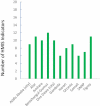Routine health management information system data in Ethiopia: consistency, trends, and challenges
- PMID: 33446081
- PMCID: PMC7833046
- DOI: 10.1080/16549716.2020.1868961
Routine health management information system data in Ethiopia: consistency, trends, and challenges
Abstract
Background: Ethiopia is investing in the routine Health Management Information System. Improved routine data are needed for decision-making in the health sector. Objective: To analyse the quality of the routine Health Management Information System data and triangulate with other sources, such as the Demographic and Health Surveys. Methods: We analysed national Health Management Information System data on 19 indicators of maternal health, neonatal survival, immunization, child nutrition, malaria, and tuberculosis over the 2012-2018 time period. The analyses were conducted by 38 analysts from the Ministry of Health, Ethiopia, and two government agencies who participated in the Operational Research and Coaching for Analysts (ORCA) project between June 2018 and June 2020. Using a World Health Organization Data Quality Review toolkit, we assessed indicator definitions, completeness, internal consistency over time and between related indicators, and external consistency compared with other data sources. Results: Several services reported coverage of above 100%. For many indicators, denominators were based on poor-quality population data estimates. Data on individual vaccinations had relatively good internal consistency. In contrast, there was low external consistency for data on fully vaccinated children, with the routine Health Management Information System showing 89% coverage but the Demographic and Health Survey estimate at 39%. Maternal health indicators displayed increasing coverage over time. Indicators on child nutrition, malaria, and tuberculosis were less consistent. Data on neonatal mortality were incomplete and operationalised as mortality on day 0-6. Our comparisons with survey and population projections indicated that one in eight early neonatal deaths were reported in the routine Health Management Information System. Data quality varied between regions. Conclusions: The quality of routine data gathered in the health system needs further attention. We suggest regular triangulation with data from other sources. We recommend addressing the denominator issues, reducing the complexity of indicators, and aligning indicators to international definitions.
Keywords: Data Quality; HMIS; RHIS; Routine Health Information System; WHO data quality review toolkit.
Conflict of interest statement
No potential conflict of interest was reported by the authors.
Figures



References
-
- Central Statistical Agency, Ethiopia . Ethiopia demographic and health survey 2016 [Internet]. 2016. [cited 2020 Mar 16]. Available from: https://www.csa.gov.et
-
- Ethiopian Public Health Institute and ICF . 2019 Ethiopia mini demographic and health survey. 2019.
-
- Ministry of Health, Ethiopia . Health sector transformation plan (HSTP) 2015/16-2019/20 [Internet]. 2015. [cited 2019 Oct 9]. Available from: https://www.globalfinancingfacility.org/sites/gff_new/files/Ethiopia-hea...
-
- Ministry of Health, Ethiopia . Information revolution. Addis Ababa: Ministry of Health; 2020. http://www.moh.gov.et/ejcc/am/Information_Revolution_Booklet
Publication types
MeSH terms
LinkOut - more resources
Full Text Sources
Other Literature Sources
